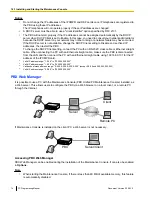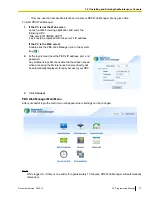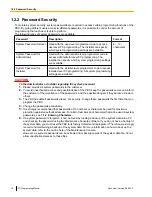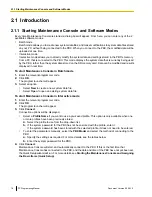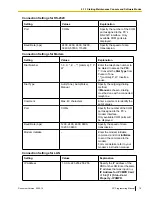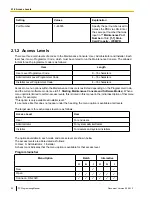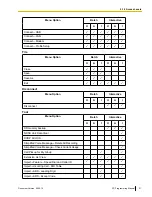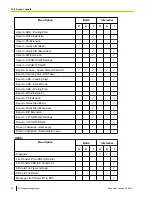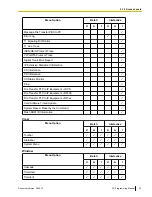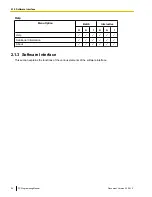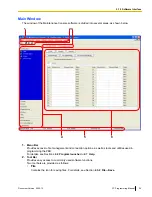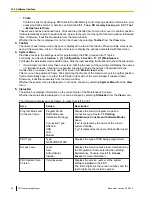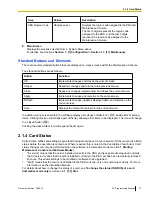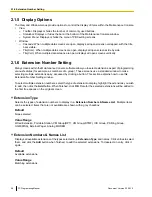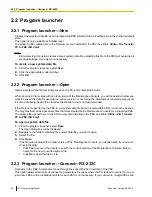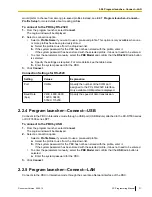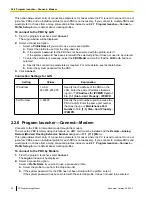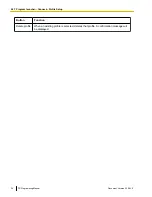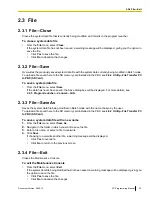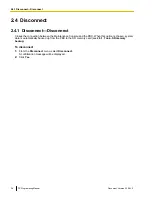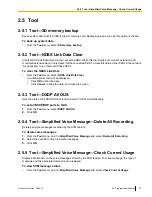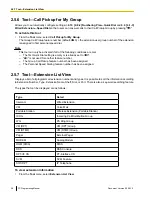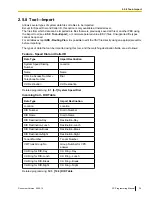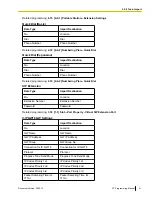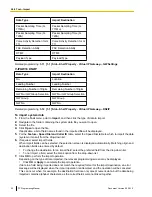
2.1.5 Display Options
The View and Window menus provide options to control the display of items within the Maintenance Console.
•
View
–
Toolbar: Displays or hides the tool bar of commonly used buttons.
–
Statusbar: Displays or hides the bar at the bottom of the Maintenance Console window.
–
System Menu: Displays or hides the menu of PBX setting screens.
•
Window
–
Cascade: When multiple data screens are open, displays all open screens overlapped, with the title
bars visible.
–
Tile(Horz): When multiple data screens are open, displays all open screens side by side.
–
Tile(Vert): When multiple data screens are open, displays all open screens vertically.
2.1.6 Extension Number Setting
Many screens within the Maintenance Console software allow you to select extensions as part of programming
various features (for example, as members of a group). These screens use a standard window to make
selecting multiple extensions easy, accessed by clicking a button. This section explains how to use this
Extension Number Setting window.
To select multiple extension numbers, select the type of extension to display, highlight the extensions you wish
to add, then click the
Add
button. When finished, click
OK
. Data for the selected extensions will be added to
the first free spaces on the original screen.
Extension Type
Selects the types of extension numbers to display in
Extension Numbers & Names List
. Multiple items
can be selected. Items that are not available are shown with a grey checkbox.
Default
None selected.
Value Range
Wired Extension, Portable Station, VM Group(DPT), VM Group(DTMF), ICD Group, PS Ring Group,
OGM(DISA), External Pager, Analog MODEM
Extension Numbers & Names List
Displays all available extensions of the types selected in
, and names. Click entries to select
them, and click the
Add
button when finished, to add the selected extensions. To deselect an entry, click it
again.
Default
Available extensions.
Value Range
Matching extensions
28
PC Programming Manual
Document Version 2009-12
2.1.6 Extension Number Setting
Summary of Contents for KX-NCP500
Page 71: ...Section 3 1 Configuration Document Version 2009 12 PC Programming Manual 71 ...
Page 74: ... 3 4 1 Virtual Cards 74 PC Programming Manual Document Version 2009 12 3 1 1 1 Slot ...
Page 313: ...Section 4 2 System Document Version 2009 12 PC Programming Manual 313 ...
Page 450: ...450 PC Programming Manual Document Version 2009 12 4 21 2 11 2 Audio Gain Card ...
Page 451: ...Section 5 3 Group Document Version 2009 12 PC Programming Manual 451 ...
Page 533: ...Section 6 4 Extension Document Version 2009 12 PC Programming Manual 533 ...
Page 701: ...Section 7 5 Optional Device Document Version 2009 12 PC Programming Manual 701 ...
Page 731: ...Section 8 6 Feature Document Version 2009 12 PC Programming Manual 731 ...
Page 744: ...744 PC Programming Manual Document Version 2009 12 8 6 6 6 Tenant ...
Page 745: ...Section 9 7 TRS Document Version 2009 12 PC Programming Manual 745 ...
Page 753: ...Section 10 8 ARS Document Version 2009 12 PC Programming Manual 753 ...
Page 766: ...766 PC Programming Manual Document Version 2009 12 10 8 8 7 Authorization Code for TRG ...
Page 767: ...Section 11 9 Private Network Document Version 2009 12 PC Programming Manual 767 ...
Page 780: ...780 PC Programming Manual Document Version 2009 12 11 4 9 4 NDSS Key Table ...
Page 781: ...Section 12 10 CO Incoming Call Document Version 2009 12 PC Programming Manual 781 ...
Page 807: ...Section 13 11 Maintenance Document Version 2009 12 PC Programming Manual 807 ...
Page 847: ...Section 14 Appendix Document Version 2009 12 PC Programming Manual 847 ...

